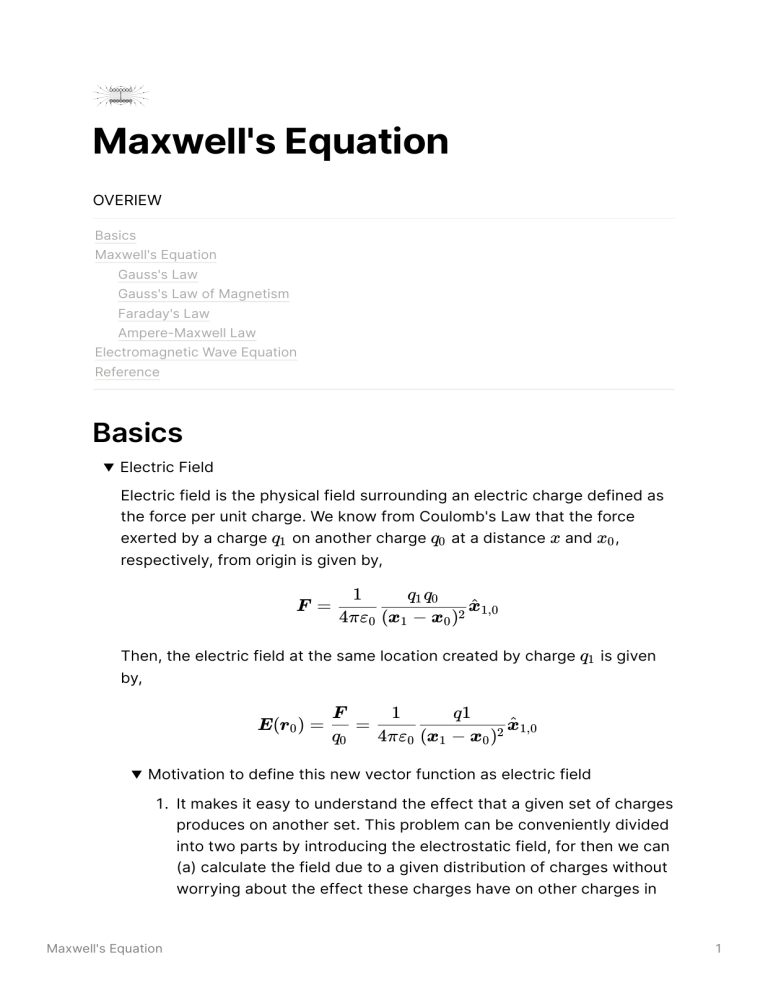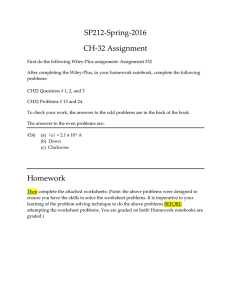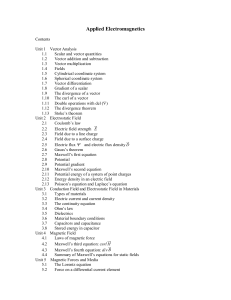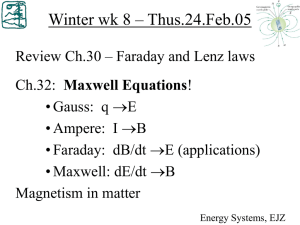
Maxwell's Equation OVERIEW Basics Maxwell's Equation Gauss's Law Gauss's Law of Magnetism Faraday's Law Ampere-Maxwell Law Electromagnetic Wave Equation Reference Basics Electric Field Electric field is the physical field surrounding an electric charge defined as the force per unit charge. We know from Coulomb's Law that the force exerted by a charge q1 on another charge q0 at a distance x and x0 , respectively, from origin is given by, F = 1 q1 q0 x ^ 1,0 4πε0 (x1 − x0 )2 Then, the electric field at the same location created by charge q1 is given by, E(r0 ) = F 1 q1 ^ 1,0 = x q0 4πε0 (x1 − x0 )2 Motivation to define this new vector function as electric field It makes it easy to understand the effect that a given set of charges produces on another set. This problem can be conveniently divided into two parts by introducing the electrostatic field, for then we can (a) calculate the field due to a given distribution of charges without worrying about the effect these charges have on other charges in Maxwell's Equation 1 the vicinity and (b) calculate the effect a given field has on charges placed in it without worrying about the distribution of charges that produced the field. It turns out that all classical electromagnetic theory can be codified in terms of four equations, called Maxwell's equations, which relate fields (electric and magnetic) to each other and to the charges and currents which produce them. Thus, electromagnetism is a field theory and the electric field ultimately plays a role and assumes an importance which far transcends its simple elementary definition as "force per unit charge." Very often it is convenient to treat a distribution of electric charge as if it were continuous. To do this, we proceed as follows. Suppose in some region of space of volume a V the total electric charge is a Q. We define the average charge density in ΔV as, ρˉΔV = ΔQ ΔV Using this, we can define the charge density at the point (x, y, z), denoted ρ(x, y, z), by taking the limit of ρˉΔV as ΔV shrinks down about the point (x, y, z): ⁍ Thus, the electric charge in some region of volume V can then be expressed as the triple integral of ρ(x, y, z) over the volume V ; that is, Q = ∭ ρ(x, y, z) dV V Then, the Electric Field at distance x contributed by a continuous distribution of charges at point x′ , is given by, 1 ρ(x′ ) dV ′ E(r0 ) = ∭ x ^ ′ 2 4πε0 V (x − x) ′ where x ^ is the unit vector pointing from x′ to x. Surface Integral and Divergence Maxwell's Equation 2 In three-dimensional Cartesian coordinates, the divergence of a continuously differentiable vector field F = Fx i + Fy j + Fz k is defined as the scalar valued function obtained by dot product, div F = ∇ ⋅ F = ( ∂ ∂ ∂ ∂Fx ∂Fy ∂Fz , , ) ⋅ (Fx , Fy , Fz ) = + + ∂x ∂y ∂z ∂x ∂y ∂z Line Integral and Curl The curl of a vector field F = Fx i + Fy j + Fz k, denoted by ∇ × F is given by the cross product. ∇×F= ∇×F=( ∣ ^ ^ ^ ∣ k ∂ ∂x ∂ ∂y ∂ ∂z ∣ Fx Fy Fz ∣ ∂Fz ∂Fy ∂Fx ∂Fz ∂Fy ∂Fx ^ − ) ^ + ( − ) ^ + ( − )k ∂y ∂z ∂z ∂x ∂x ∂y Gradient 💡 There is a single EM field that changes its appearance from for different observers. E to B Maxwell's Equation Introduction Maxwell's equations are a set of coupled partial differential equations that, together with the Lorentz force law, form the foundation of classical electromagnetism, classical optics, and electric circuits. All Integral equations as GIF ∬ E ⋅n ^ dA = S Maxwell's Equation q ε0 3 ∬ B ⋅n ^ dA = 0 S ∮ E ⋅ dl = − Maxwell's Equation d ∬ B⋅n ^ dA dt S 4 ∮ B ⋅ dl = μ0[I + ε0 d ∬ E ⋅n ^ dA] dt S Maxwell's equations consists of 4 equations describing 4 laws that can be expressed in two forms. Integral Form ∬ E ⋅n ^ dA = S ∑ Qenclosed ε0 ∬ B ⋅n ^ dA = 0 S ∮ E ⋅ dl = − ∬ Maxwell's Equation S ∂B ⋅n ^ dA ∂t 5 ∮ B ⋅ dl = μ0 [ ∑ Ienclosed + ε0 ∬ S ∂E ⋅n ^ dA] ∂t All Equations Differential Form ∇⋅E= ρ ε0 ∇⋅B = 0 ∇×E=− ∂B ∂t ∇ × B = μ0 (J + ε0 ∂E ) ∂t Gauss's Law Integral form Maxwell's Equation 6 ∬ E ⋅n ^ dA = S ∑ Qenclosed ε0 Law Gauss's law, also known as Gauss's flux theorem, is a law relating the distribution of electric charge to the resulting electric field. It states that the net electric flux of the electric field through any arbitrary closed surface is equal to within that closed surface, 1 times the net electric charge ε0 ΦE = Q ε0 where ΦE is the electric flux through a closed surface S enclosing any volume V , Q is the total charge enclosed within V , and ϵ0 is the electric constant. The electric flux ΦE is defined as a surface integral of the electric field: ΦE = ∬ E ⋅ dA S where E is the electric field, dA is a vector representing an infinitesimal element of area of the surface, and ⋅ represents the dot product of two vectors. The law alone is insufficient to determine the electric field across a surface enclosing any charge distribution because the total flux through that given surface gives little information about the electric field, and can go in and out of the surface in arbitrarily complicated patterns. An exception is if there is some symmetry in the problem, which mandates that the electric field passes through the surface in a uniform way. Then, if the total flux is known, the field itself can be deduced at every point. Common examples of symmetries which lend themselves to Gauss's law include: cylindrical symmetry, planar symmetry, and spherical symmetry. Where no such symmetry exists, Gauss's law can be used in its differential form, which states that the divergence of the electric field is Maxwell's Equation 7 proportional to the local density of charge. Explanation Maxwell's Equation 8 Differential form ∇⋅E= ρ ε0 Law The electric field produced by electric charge diverges from positive charge and converges upon negative charge. Explanation Derive from Integral form using small volume box ΔV . Maxwell's Equation 9 Gauss's Law of Magnetism Integral form ∬ B ⋅n ^ dA = 0 S Law The left-hand side of this equation is called the net flux of the magnetic field B out of the surface S , and Gauss's law for magnetism states that it is always zero. The law in this form states that for each volume element in space, there are exactly the same number of "magnetic field lines" entering and exiting the volume. No total "magnetic charge" can build up in any point in space. There are no magnetic flow sources, and the magnetic flux lines always close upon themselves. Also called the law of conservation of magnetic flux Maxwell's Equation 10 For example, the south pole of the magnet is exactly as strong as the north pole, and free-floating south poles without accompanying north poles (magnetic monopoles) doesn't exist. In contrast, this is not true for other fields such as electric fields or gravitational fields, where total electric charge or mass can build up in a volume of space. The law is also called "Absence of free magnetic poles". The assumption that there are no magnetic monopoles. Explanation Differential form ∇⋅B = 0 Law The divergence of the magnetic field at any point is zero. The assumption that there are no magnetic monopoles. Explanation Maxwell's Equation 11 Faraday's Law Integral form ∮ E ⋅ dl = − ∬ S ∂B ⋅n ^ dA ∂t Law A changing magnetic field induces a circulating electric field. Changing magnetic flux through a surface induces an electromotive force EMF in any boundary path of that surface. 💡 The way I see this is, whenever there is a changing magnetic field, a circulating electric field always appears, perpendicularly. And if we place a wire let's say in this field, the electrons experience force giving rise to EMF induction. The voltage accumulated around a closed circuit is proportional to the time rate of change of the magnetic flux it encloses. Explanation Maxwell's Equation 12 Differential form ∇×E=− ∂B ∂t Law A circulating electric field is produced by a magnetic field that changes with time. The Maxwell–Faraday equation states that a time-varying magnetic field always accompanies a spatially varying (also possibly timevarying), non-conservative electric field, and vice versa. Explanation Ampere-Maxwell Law Integral form Maxwell's Equation 13 ∮ B ⋅ dl = μ0 [ ∑ Ienclosed + ε0 ∬ S ∂E ⋅n ^ dA] ∂t Law An electric current I or a changing electric flux through a surface produces a circulating magnetic field around any path that bounds that surface. Electric currents and changes in electric fields are proportional to the magnetic fields circulating about the areas where they accumulate. Explanation The second term was added by Maxwell which explains the case of a capacitor. Here the surface bounded by closed path C is bulged such that the current ic doesn't penetrate this surface, meaning it is not enclosed in this surface. However, since the electric field penetrate this surface, which appears in the equation above that gives the circulating magnetic field around it. Maxwell's Equation 14 Differential form ∇ × B = μ0 (J + ε0 ∂E ) ∂t Law A circulating magnetic field is produced by an electric current and by an electric field that changes with time. Explanation Derive from integral form using closed path with small area ΔA. Maxwell's Equation 15 Maxwell's Equation 16 Electromagnetic Wave Equation Derivation To obtain the electromagnetic wave equation in a vacuum using the modern method, we begin with the modern 'Heaviside' form of Maxwell's equations. In a vacuum- and charge-free space, these equations are: ∇⋅E= 0 ∇×E=− ∇⋅B = 0 ∂B ∂t ∇ × B = μ0 ε0 ∂E ∂t These are the general Maxwell's equations specialized to the case with charge and current both set to zero. Taking the curl of the curl equations gives: ∂B ∂ ∂2 E ∇ × (∇ × E) = ∇ × (− ) = − (∇ × B) = −μ0 ε0 2 ∂t ∂t ∂t ∂E ∂ ∂2 B ∇ × (∇ × B) = ∇ × (μ0 ε0 ) = μ0 ε0 (∇ × E) = −μ0 ε0 2 ∂t ∂t ∂t We can use the vector identity Maxwell's Equation 17 ∇ × (∇ × V) = ∇ (∇ ⋅ V) − ∇2 V where V is any vector function of space. Since ∇⋅E= 0 ∇⋅B = 0 then the first term on the right in the identity vanishes and we obtain the wave equations: ∂2 E μ0 ε0 2 = ∇2 E ∂t ∂2 E ∂2 E ∂2 E ∂2 E μ0 ε0 2 = ( 2 + + ) ∂t ∂x ∂y2 ∂z 2 similarly, μ0 ε0 ∂2 B ∂2 B ∂2 B ∂2 B = ( + + ) ∂t2 ∂x2 ∂y2 ∂z 2 which is a wave equation, where, the speed of the wave c0 is given by, c0 = 1 = 2.99792458 × 108 m/s μ0 ε0 is the speed of light in free space. EM Wave spectrum Maxwell's Equation 18 Reference Plain Explanation of Maxwell Equation Lecture 26 Maxwell Equation by Prof. Carlson Accelerated Charges Radiating Electromagnetic Waves Episode 39 Maxwell's Equation - The Mechanical Universe by Caltech Electromagnetic Waves - with Sir Lawrence Bragg Electric and Magnetic Field from Power Lines by BC Hydro Moving magnet and conductor problem The moving magnet and conductor problem is a famous thought experiment, originating in the 19th century, concerning the intersection of classical electromagnetism and special relativity. In it, the current in a conductor moving with constant velocity, v, with respect to a magnet is calculated in the frame of reference of the magnet and in the frame of reference of the conductor. The observable quantity in the experiment, the current, is the same in either case, in accordance with the basic principle of relativity, which states: "Only relative motion is observable; there is no absolute standard of rest". If one is in a frame that is at rest with respect to the magnet and the conductor is moving, then the induced emf is a result of the Lorentz force acting on the charge carries moving in a magnetic field. Maxwell's Equation 19 On the other hand, if one is in a frame at rest with respect to the conductor and the magnet is moving, the induced emf results from the variation in the magnetic flux which produces electric field. Thus, according to Maxwell's equations, the charges in the conductor experience a magnetic force in the frame of the magnet and an electric force in the frame of the conductor. The same phenomenon would seem to have two different descriptions depending on the frame of reference of the observer. Which, in Einstein's word, "For if the magnet is in motion and the conductor at rest, there arises in the neighbourhood of the magnet an electric field with a certain definite energy, producing a current at the places where parts of the conductor are situated. But if the magnet is stationary and the conductor in motion, no electric field arises in the neighbourhood of the magnet. In the conductor, however, we find an electromotive force, to which in itself there is no corresponding energy, but which gives rise – assuming equality of relative motion in the two cases discussed – to electric currents of the same path and intensity as those produced by the electric forces in the former case." Maxwell's Equation 20






